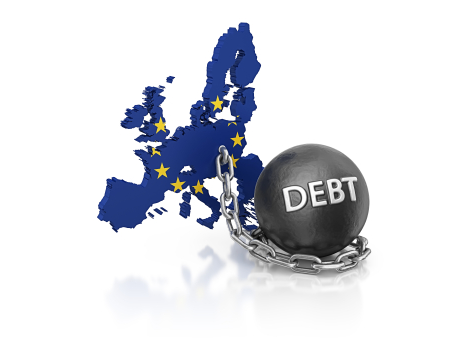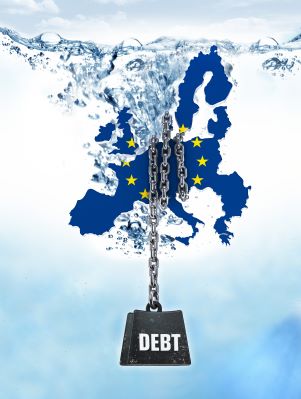Why Europe is setting itself up for the next sub-prime crisis

"No one wants to lend to a country when that country would use the loan to pay the interest on previous loans - that's throwing good money after bad."
This comment made by a BBC business analyst in November 2011 made a lot of sense – investment-wise. Why would anyone lend to someone who is drowning in debt and is struggling to pay off the interest on previous loans?
If we think deeper, how is this any different from a Ponzi scheme which requires ever increasing amounts of capital from new investors to pay off interest plus principal of those who ‘invested’ earlier?
2011 – Investors are wary to lend to Italy
That comment was made during the Eurozone crisis when the borrowing costs of the Italian government reached a record high of 7.48% on the benchmark 10-year Italian government bond. Investors were hesitant to lend to the country without a debt management plan in sight.
The 7-percent mark was significant because it was a level deemed too expensive for governments to borrow money in the markets. The governments of Ireland and Portugal had sought for bailout shortly after their bond yields breached this mark.
The year 2011 also saw Irish government 10-year bonds hit a high of 11.8% and Portuguese 10-year bonds reached 13.9%. When the yield on a bond is high, it shows that the demand for the bond is low amongst investors because they deem it risky to lend with the bond. The issuer of the bond has to pay higher interest on the bond to attract investors.
2015 – Investors pay to lend to Italy
Four years later in 2015, it was a different story. Reuters reported on 28 October 2015 that for the first time ever, Italy sold EUR 6 billion of its 6-month bills at a yield of -0.055%. Compare this to 2011 where the yield on the 6-month bill reached a high of 6.4%.
The negative yield also went out to Italian 2-year bills which they sold for EUR 1.75 billion at a yield of -0.023%.
This was a mind-blowing development because it implied that investors are now paying Italy to lend to its government.
Has the Italian government fixed its finances to deserve such immense confidence from investors? Definitely not. Italy now has a debt-to-GDP ratio of 132%, higher than the 116% recorded in 2011. Government debt ballooned to a high of EUR 2.2 trillion in May 2015. Italy still holds the unenvious position of having the second highest debt-to-GDP ratio in the Eurozone after the beleaguered Greek government.
So why would investors now pay to lend to such heavily indebted countries?

Banks’ mistrust to lend to consumers and businesses
The Eurozone rate of inflation has been steadily declining since the last quarter of 2011 and has gone below the European Central Bank’s (ECB) target of 2-percent since 2013. The ECB views the lack of lending by the banks as the major cause of the decline in the rate of inflation.
The banks are not lending their reserves because of the perceived risks from potential borrowers (consumers and businesses) at a time when the Eurozone economy is still limping along. They deem it safer to park their reserves with the ECB and earn a risk-free deposit interest on reserves from the central bank.
In its bid to force banks to increase lending, the ECB took an unprecedented step in June 2014 to cut the deposit rate to -0.1% and a further cut to -0.2% in September 2015. Now, banks are paying the central bank to keep their reserves.
In addition, the ECB has also launched a quantitative easing (QE) bond-purchasing program in January 2015 worth at least EUR 1.1 trillion. The aim was to support the prices of bonds, the main asset class held by banks, thereby improving banks’ balance sheets. This was to further incentivise the banks to extend loans.
Unfortunately, the banks’ mistrust of the weak economy is so deep that even such a drastic cut of the deposit rate failed to ignite significant growth of lending towards consumer spending and businesses. Banks are still using the bulk of the funds supplied by the ECB to finance Eurozone governments through bond purchases. Other investors follow the cue of the banks and join the bandwagon seeking profit from yield or currency movements.
Bank’s misplaced trust in riskiest of sovereign debt
With a negative deposit rate of -0.2% and the ECB virtually guaranteeing the buyback of Eurozone government bonds, even the debt of riskier countries like Italy or Portugal seemed a safer bet than extending loans to consumers and businesses.
Lending money to the Italian government at -0.023% with a 2-year bill is seen as making a smaller loss than paying -0.2% to the ECB if the funds were unutilised.
The ability of the ECB to conjure euros out of thin air has given them the exorbitant privilege to back the debt of the riskiest of Eurozone governments. All of a sudden, sub-prime debtors are transformed into prospective borrowers. We are looking at the makings of the next sub-prime crisis in Europe with the difference this time being that the sub-prime borrowers are highly indebted sovereign nations.
In this era of ‘cheap money’, we see financial institutions loaded up with toxic paper ‘assets’. Our only option for wealth protection is through the safety of hard assets and the best of them are physical precious metals.
